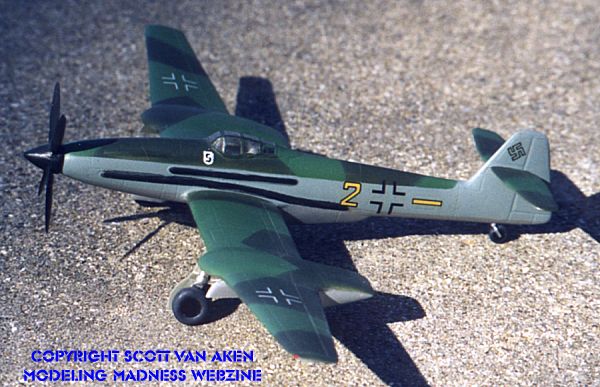
Kit: Wings 72 1/72 Bv-155
Kit Number: ?
Price: about $10.00
Media: Vacuform Plastic
Decals: None
Date of Review: 6 May 1998
Review and Photo by: Scott Van Aken

The Bv-155 was to be a high altitude interceptor. Originally started by Messerschmitt, but turned over to Blohm & Voss, this radical aircraft went through a number of changes during its gestation period. Destined not to enter service or even to make many test flights, it would have been an unusual sight in the air over the Reich.
This kit was built well over ten years ago, when I was just starting to learn how to build vacuformed kits. It is an oldie but a goodie coming with no resin, white metal or injected parts. I had to scratch build the landing gear and find a prop from the spares box. The most difficult part of construction, to me, is sanding down the parts. I inevitably take off too much and have to fill in the gaps with sheet styrene and putty. A problem I still have with vacuform kits :(
This one is typical of the genre. Once the parts are cut out and sanded down, reinforcement tabs are installed on the fuselage for added strength. The cockpit is basic, but good enough, consisting of a floor, back wall, seat and instrument panel. A control stick was scrounged from the spares box. The fuselage had the appropriate vents and intakes opened up. The lower fuselage intake was boxed off with styrene sheet to prevent the ever-popular see-through look. In addition, the huge wing radiators were also boxed off and a representation of the radiators made by scoring plastic sheet in a radiator core like pattern.
As you can see, the wings are very long, so a spar was made to help keep them from cracking at the wing fuselage join. A propeller from a P-61 was determined to be as close as possible for this aircraft and used. The prop was placed in the vacuformed spinner, and then the assembly was filled with epoxy. When done it was trimmed at the back. Looks pretty good. The landing gear was scratchbuilt from various lengths of aluminum tubing, although the kit wheels were used. The tail wheel is actually the nose-wheel of a 1/72 F-16 suitably sanded down.
Since this is a Luftwaffe '46 aircraft, it was painted in late war colors of 81/83/76 using Xtracolor paints. Decals were scrounged from the spares box and the whole kit given several coats of matte clear. Unfortunately, I put on the coats too thick and too close to each other, for a few years later, the paint started to show cracks due to the underlying coats not drying completely before the upper coats were applied.
So there you have it! An interesting addition to anyone's Luftwaffe collection. While I would doubt that today's spoiled modeler (those that build only those kits with all the goodies) would try such a thing, I can recommend it to the rest of us who don't mind using their hard gained modelling (or assembling) skills:)